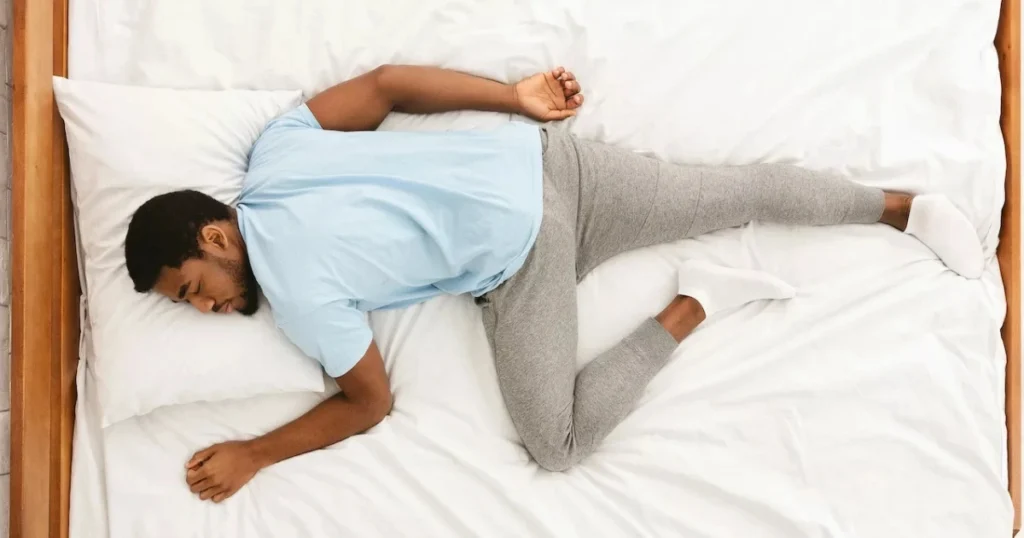Most people think that the secret to waking up refreshed is simply getting more hours of sleep. But while sleep duration is important, your sleeping position can have just as much impact—sometimes even more—on your health, comfort, and energy levels. The way you lie down each night can affect your spine, breathing, digestion, skin, and even your circulation.
One particular sleep posture stands out as the most damaging. It’s time to understand why—and learn how to make small adjustments that can transform your sleep quality and overall well-being.

Why Your Sleeping Position Matters
When your body is properly supported during sleep, your muscles can relax, your joints can recover, and your nervous system can reset. Poor positioning, however, puts strain on your spine, compresses your organs, and can lead to disrupted breathing or blood flow.
If you regularly wake up with a sore neck, stiff back, or puffy skin, your posture in bed could be part of the problem.
The Health Risks of Sleeping on Your Stomach
While many find stomach sleeping comforting, research shows it’s one of the least supportive positions for your body.
1. Spinal and Neck Strain
Lying face-down forces your neck to twist for hours, creating tension in your cervical spine. Over time, this can cause chronic stiffness, muscle pain, or even nerve compression. The lower back is also affected—your spine arches unnaturally, increasing stress on the lumbar region and raising the risk of disc problems or sciatica.
2. Restricted Breathing
Face-down positioning compresses the chest and diaphragm, making deep breathing harder. This reduces oxygen intake during important stages like REM sleep, leaving you less rested. For those with mild sleep apnea or snoring, this position can worsen symptoms.
3. Skin Damage and Premature Aging
Pressing your face into a pillow all night accelerates the formation of wrinkles and can contribute to uneven skin tone or breakouts. Continuous pressure also causes fluid retention, leading to morning puffiness.
4. Poor Circulation
Stomach sleeping can compress blood vessels and internal organs, leading to numbness or tingling in your arms or legs. Over time, this may contribute to reduced circulation and nerve irritation.
Better Sleep Positions for Your Body
If you want to improve your sleep quality, switching from stomach sleeping to a healthier posture is key.
Back Sleeping (Starfish Position)
Sleeping on your back with arms and legs relaxed allows for even weight distribution and neutral spinal alignment. It can reduce back and neck pain, and also help minimize facial wrinkles. Elevating your head slightly can also relieve acid reflux symptoms.
Left-Side Sleeping
This position supports digestion and reduces acid reflux by keeping stomach acids below the esophagus. It also promotes better blood circulation, making it a recommended posture for pregnant individuals and those with heartburn.
Right-Side Sleeping
While slightly less effective for acid reflux than the left side, right-side sleeping is still a good option for comfort and spinal health. It can also help ease pressure on the heart and is often easier for those transitioning away from stomach sleeping.
Tips for Transitioning to a Healthier Sleep Position
Changing your sleep posture can take time, but small adjustments make the process easier.
- Invest in supportive pillows: An orthopedic or contoured pillow can help keep your head and neck aligned.
- Use a body pillow: Placing it in front of you when side sleeping or alongside you on your back makes rolling onto your stomach less likely.
- Choose the right mattress: Medium-firm mattresses support your spine without causing discomfort.
- Support your legs: When side sleeping, place a pillow between your knees to keep hips aligned.
Personality Insights from Sleep Postures
Studies suggest that sleep positions may loosely correlate with certain lifestyle patterns:
- Back sleepers tend to wake more energized and are often focused on health.
- Left-side sleepers are frequently structured and routine-oriented.
- Right-side sleepers may prioritize comfort after long workdays.
- Stomach sleepers sometimes experience higher stress or irregular sleep cycles.
While these associations are not definitive, they highlight how personal habits and comfort preferences can influence the way we rest.
Frequently Asked Questions
1. Is stomach sleeping ever okay?
It’s not recommended, but if you can’t sleep any other way, use a very thin pillow or none at all to reduce neck strain.
2. How long does it take to change sleep positions?
Most people adjust within two to four weeks, especially if they use supportive pillows.
3. Which position is best for lower back pain?
Sleeping on your back with a pillow under your knees or on your side with a pillow between your legs can relieve pressure on the spine.
4. Can my pillow cause neck pain?
Yes. A pillow that’s too high or too flat can misalign the neck and spine.
5. Does sleep position affect snoring?
Yes. Sleeping on your side or back with slight head elevation can reduce snoring for some people.
Internal Linking Suggestions (secretsofthegreengarden.com)
- Best Plants for a Bedroom That Promotes Better Sleep
- Natural Remedies for Reducing Stress Before Bed
- How to Create a Sleep-Friendly Indoor Garden
External Linking Suggestions
- National Sleep Foundation: Healthy Sleep Tips
- Mayo Clinic: Sleep Positions and Health
- Cleveland Clinic: How Your Sleep Position Affects Your Health
Main Keyword: best sleep position for health
LSI/NLP Keywords: sleeping posture benefits, stomach sleeping risks, side sleeping for digestion, back sleeping for spine health, improve sleep quality, change sleep position, spine alignment during sleep, pillows for better sleep

